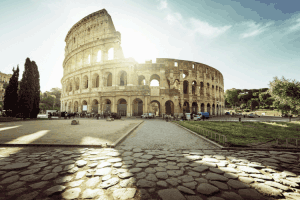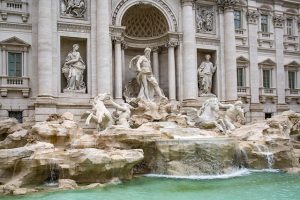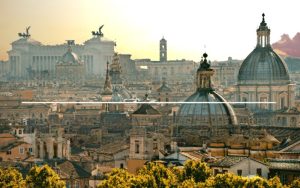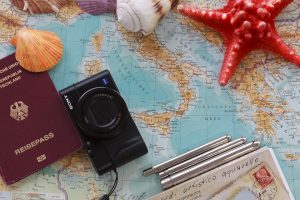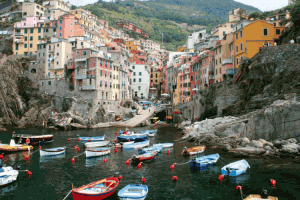This article takes you on a hauntingly beautiful tour through Etruscan and Roman heartlands. Water courses and breathtaking scenery mark these regions, which have been shaped by natural and human forces. You travel through lush, fertile land, visit interesting towns, and sample the local food and wine.
History of the Etruscans
The Etruscans were a powerful civilization in west-central Italy during the 8th to the 4th centuries BCE. Various scholars debated their origin, where some suggested migration from Asia Minor, and others proposed indigenous roots from the Villanovan Civilization from the Iron Age.
However, their fame is due to their advanced commercial society built on agriculture, trade, and mining. We learn about them mainly through discoveries in their ornate tombs, emphasizing their elaborate burial practices.
Before Etruscan influence, Rome was a small village, but under the Etruscans, the city saw the construction of significant public works, marking a pivotal period in its history. The Capitol region in Rome reveals evidence of this thriving civilization, showcasing their commercial and agricultural prowess.
Art & Culture of the Etruscans
The Etruscan civilization’s art, history, and literature are said to have left a legacy in Italy. Their art mostly was figurative sculpture in terracotta, wall paintings, and detailed metalworking discovered through tombs. Their wall paintings depicted scenes of feasting and mythological notions to give us a glimpse into their cultural way of living.
Etruscans are believed to have spoken a unique Pre-Indo-European and Paleo-European language, identified as related to the Tyrsenian language family. Diodorus Siculus, in the 1st century BC, said that the Etruscans in Italy were very powerful concerning their literature but with less evidence, it remains a mystery.
Their religion and belief system perceived every phenomenon as a manifestation of divine power. This divine power was represented by deities such as Catha, Usil, Tivr, Selvans, Turan, Laran, Leinth, Maris, Thalna, Terms, and the well-known Fufluns. Thus, the Etruscan civilization, as evidenced by its art, language, and beliefs, is a fascinating chapter in ancient history with so many silent aspects about them yet to be discovered.
What made Etruscans unique?
Firstly, the disputed origin, artistic influence, and commercial flourishment make the Etruscans a unique subject to be curious about. Their innovative capacity, beliefs, fashion, and culture during such ancient times are also regarded to be fascinating. Also, while the whole world still is struggling to put women on an equal footing as men, their traces don’t suggest any such discrimination. Lastly, their sudden disappearance with so little to research about, contributes to interest in their study.
Amazing Etruscan Sites in Italy
1. Elba Island
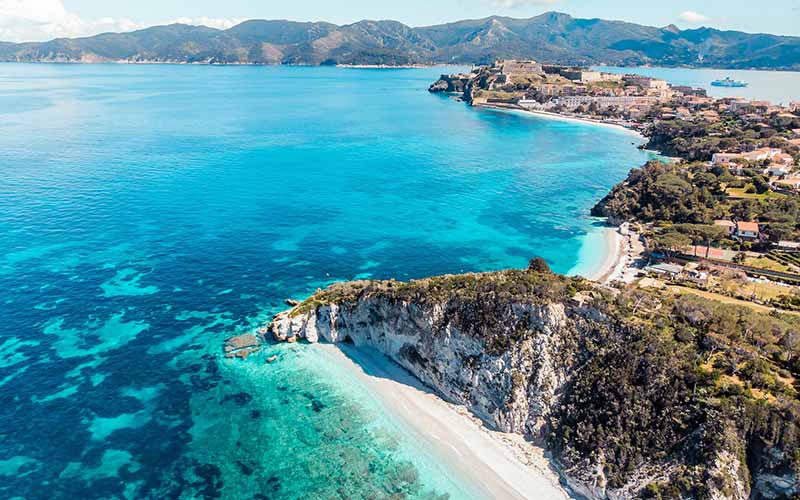
The Etruscans were a mysterious and vast civilization that existed long before the Romans took over the peninsula. Many traces of these ancient people can still be found today, particularly along the “Etruscan Coast” and in the Maremma, but did you know they also made their way to the Isola d’Elba? There are fewer traces of their presence on the island than on the mainland, but there are still some things to see if you know where to look.
- The Mineral District Archeological Museum and Rio nell’Elba
Mining was a primary activity of the Etruscans on the Isola d’Elba, as the island is a gold mine (pun intended!) of underground mineral resources. During the Etruscan era, iron extraction was especially active, connecting the civilization to the other surrounding islands and the mainland. Ceramics, bronze crockery from Elban tombs, and grave goods from the Buraccio necropolis attest to the Etruscan presence on the island during the early Iron Age.
- Elba Island Mineral Park in Rio Marina
Iron mining has long been a major industry on the Isola d’Elba, including in Rio Marina, where the Mineral Park displays this type of production. Visitors can tour the mines with an expert guide on foot or aboard the park’s “little red train,” exploring the main mines in the area, some of which go as back as the Etruscan era. Also visit the science museum housed inside Palazzo del Bur, home to one of the most important mineral collections on Elba and a reconstruction of a mine.
- The Civic Archeological Museum in Marciana
Marciana, on Elba’s northwestern coast, is one of the island’s oldest settlements. The town’s archeological museum displays tools and artifacts from the island’s millennia-old history. There is an entire section dedicated to Etruscan history, with artifacts from various ancient settlements, including brooches and kylikes (cups) from Monte Giove, and amphorae and black-glazed vases from the Etruscan fort of Monte Castello off the coast of Procchio.
- Capoliveri Hellenistic-era necropolis
Explore the Hellenistic-era necropolis discovered in 1816 on the outskirts of Capoliveri for an outdoor excursion. Wine jugs, ceramics, and jewelry were among the items unearthed at the burial site. The artifacts have since been relocated to the Archeological Museum in Portoferraio, so we recommend concluding your tour of Elba’s Etruscan history in the island’s northern city. Visit more such fascinating museums in Rome and Italy to uplift your art experience.
2. Cortona
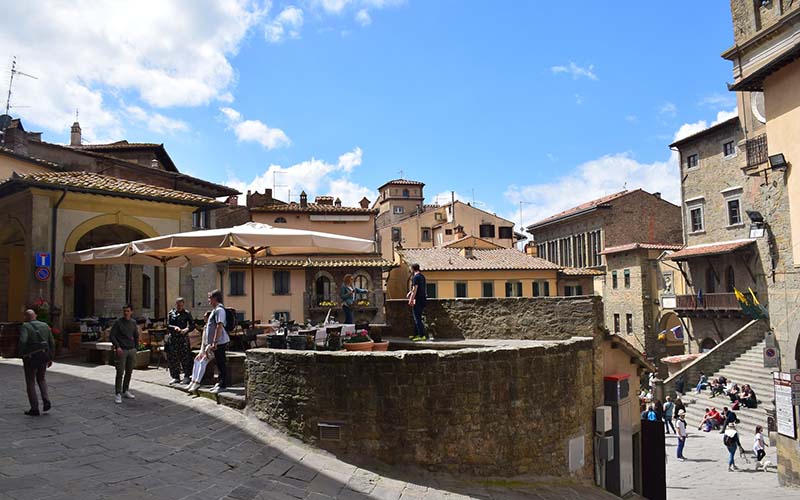
As you explore Cortona, the Etruscan past becomes clear, with the town’s large walls and double lancet door, as well as the underground structures, such as the vaulted arch of the Cerulli Diligenti Palace, the barrel vault of the Via Guelfa road, and the Etruscan wall of the Casali Palace. Along the MAEC’s hiking trails and cycling routes, you can see evidence of the spectacular Etruscan and Roman eras.
The Etruscan “tumulo” or mound structure of Sodo II is unique in the world due to the beauty of its horizontal architecture and ornate terrace-stair structure. This, however, is not the only breathtaking sight in the park. As you walk through these hills’ old olive groves, you will come across the Tanella di Pitagora, the Tanella Angori, and the tomb of Mezzavia. If you enjoy archeology and hiking, you can enter the area via a dense network of Roman-era stone roads recently excavated just above the area in the Cortona mountains. The remains of the beautiful republican, imperial villa of Ossaia can be seen on the side of the mountain of Cortona, with a wonderful view of Lake Trasimeno.
3. In and around Orvieto
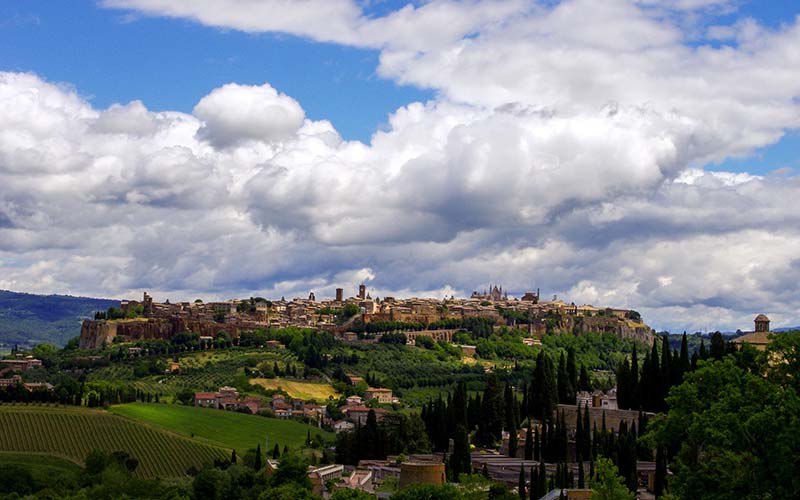
When the Romans finally conquered the entire region of Umbria, Orvieto was the last of the Etruscan cities to fall.
Many traces of the pre-Roman world of the Etruscan city of Velzna, now Orvieto, still remain, and they are among the best preserved in Umbria. So get ready for an exciting tour that begins in the town center. The Archaeological Area of the Tempio del Belvedere has preserved beautiful architectural terracotta here, which can now be seen in nearby museums. The Museo Claudio Faina, Museo Civico, and National Archaeological Museum are all located in the center of town, not far from the lovely Piazza Duomo.
To learn more about this ancient civilisation, leave the city center and head to the city’s south-eastern slopes, where you will find the extensive Necropoli di Crocifisso del Tufo.Walk along clearly marked “streets” around neat blocks containing over 300 tombs dating from the 4th and 2nd centuries BCE. The Necropolis and Sanctuary of the Cannicella can also be toured on foot along the southern end along the paths of the Archaeological Park of Orvietano (PAO); book your visit in advance.
4. Sarteano
Sarteano, a charming town sheltered inland between the Val d’Orcia and the Valdichiana, is a good place to start learning about Etruscan history in Tuscany. Not only does the town and surrounding area have breathtaking views, but Sarteano itself is rich in ancient history, making this Tuscan town a must-see for archeology buffs. Indeed, Sarteano has been inhabited since prehistoric times, as evidenced by remarkable.
The Sarteano Etruscan Museum, which conserves several discoveries made during excavations in this area, is a great place to get an overall understanding of Etruscan presence in this area. Many of the artifacts come from Etruscan tombs scattered throughout the area and are housed in the 16th-century Palazzo Gabrielli, including human-shaped funerary urns, a memorial stone from the town of Sant’Angelo depicting scenes of an Etruscan funeral, and a life-size reconstruction of the painted 4th-century tomb known as the Infernal Chariot, one of the most important examples of Etruscan art.
4 places of Etruscan settlement
The Etruscan land, Etruria, included 12 city-states between the Arno and Tiber rivers, which currently include cities like Carveteri, Chiusi, Populonia & Tarquinia.
1. Cerveteri
Cerveteri is known for its ancient Etruscan city, especially the Banditaccia Necropolis. This place has old tombs with bits of wall paintings that tell stories of the past. In the National Museum of Cerveteri, inside the Ruspoli Castle, you can see things like urns and statues from that time.
2. Chiusi
It is another major city widely populated by the Etruscans. The numerous tombs around the lower city make it a sought-after destination to discover their remains and get glimpses of Roman history. The Etruscan Museum of Chiusi contributes to the same.
3. Populonia
Populonia is special because it has great Etruscan remains, and Isidoro Falchi found one of the main necropolises in Italy here. The city’s name might come from an Etruscan god called Fufluns. Exploring Populonia helps us understand more about the Etruscans.
4. Tarquinia
This old city in central Italy was once called Corneto. Due to the magnificent number of Etruscan traces in its preserved tombs and wall paintings, it also has the title of a UNESCO World Heritage Site.
What are some interesting things about the Etruscans?
With their origins and existence being a mystery, the Etruscans also carry various other facts that can surprise you, here are some of them:
- Their belief in the afterlife made them bury people with food, jewelry, and other things to carry their earnings to the afterlife as necropolises.
- They had the largest iron reserve in the western Mediterranean with high skill in metallurgy.
- Archeological explorations reveal the existence of ovens, gas stoves, mirrors, etc.
- Their women were independent and actively participated in commerce, politics, and even owned property.
- They invented dentures, as evident from gold teeth discovered at their burial sites.
- They were highly skilled in agriculture, and trading and built Rome’s first drainage system.
FAQ’s About Etruscan
Where can Etruscan remains be found best?
Why Etruscans do not exist anymore?
Where is the best preserved Etruscan necropolis situated?
Where is the most famous Etruscan tomb?
Conclusion
By the end of the journey, having traversed these regions, one thing is clear: humanity and nature can coexist in harmony. So, this holiday season spend your days discovering the rare and historic attractions in Etruscan towns. Choose another flavour of Italian town by visiting Maratea.
